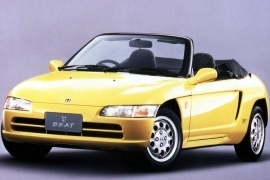
HONDA Beat
Generations Timeline, Specs and Pictures

Honda introduced the Beat in 1991 for the Japanese market, in the kei-car segment, and it re-invented the class.
While most kei-cars were boring econoboxes that looked like phone-booth on wheels, the Beat was a completely different vehicle. It was not designed to accommodate five people inside or to carry the weekly shopping. Honda made it for the customers who didn’t want to drive boring cars. It was a mid-engined roadster that could fit in the kei-car regulations and started a culture.
Honda was not at its first attempt to create a fun vehicle in the segment. The 600 did that before it, and it was successful, but the Beat was a big step forward. Its narrow headlights and short front overhang made it look longer. Its raked windshield was extended above the steering wheel. On the sides, the carmaker added air intakes for the mid-mounted engine and pushed the rear wheels to the back as far as possible. It concluded the car with an even shorter overhang than the front one.
Inside, there was room for two people separated by a center console where a short gear-stick was the main decoration. Its dashboard was comprehensive, with a proper, sloped center stack. The instrument panel looked like it was carried over from a motorcycle, especially since the tachometer had the red-line at 8,500 rpm. Behind the seats, the carmaker managed to place the removable canvas roof, which was manually operated.
Behind the cabin, the engine compartment hosted a 0.6-liter inline-three unit which featured advanced technologies for a car from that era. It was feed via individual throttle bodies and produced almost 100 hp/liter, which was very difficult for most carmakers. But not for Honda.























































